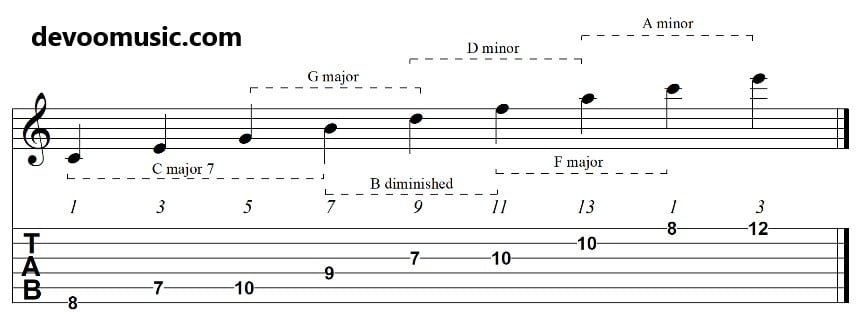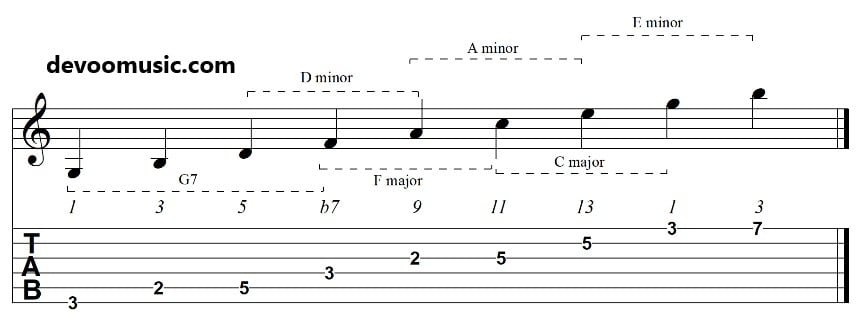Upper Structure Triads
This guitar lesson discusses a very useful way to come out new colors to your soloing or comping ideas called “Upper-structure Triads. This technique consists of superimposing triads to highlight extended notes of minor, major and dominant chords.
What’s a Triad in Music?
A triad is a set of three notes, root (R), third (3) and fifth (5) stacked in third that can be played simultaneously (chord) or one by one (arpeggio). There are four types of triads that are major (1-3-5), minor (1-b3-5), diminished (1-b3-b5) and augmented (1-3-#5).
What Are Upper Structure Triads?
Before tackling this musical concept, it is important to have a strong knowledge of the main important triads on guitar. Any self-respecting guitarist must be able to hear, recognize and play any types of triads (minor, major, diminished, augmented) using different voicings (root, inverted) and positions (close and open).
Upper structure triads are three adjacent notes built from the structure (1-3-5-7) of any seventh chord/arpeggio containing one (or more) extra note beyond the octave. These notes are the 9, 11 and 13 respectively 2, 4 and 6 up one octave. Keep in mind that the 11 is an avoid note because it clashes with the third. Let see what are the upper structure triads taken from the three most important chord types : minor, major and dominant.
Upper Structure (Triads)
Upper Structure (Triads) Of Major Chords
The tab below show the notes of the C major scale, the related arpeggio (1-3-5-7) and the extensions that come from (9-11-13). These three extended notes actually form a D minor triad made of D (root), F (b3) and A (fifth).

Upper structure triads contain at least on extension which can be the 9, 11 of 13. It means that we can build several upper triads from this major scale that are :
G – B – D, fifth (5), seventh (7) and ninth (9) of Cmaj7.
B – D – F, seventh (7), ninth (9) and eleventh (11) of Cmaj7.
D – F – A, ninth (9), eleventh (11) and thirteenth (13) of Cmaj7.
F – A – C, eleventh (11), thirteenth (13) and root (1) of Cmaj7.
A – C – E, thirteenth (13), root (1) and third (3) of Cmaj7.

The following tab show how triads are superimposed on a Cmaj7 arpeggio.

Upper Structure Triads Of Minor Chords
Now let’s take a look at the superimposed triads of a minor seventh chord (1-b3-5-b7) from the Dorian mode (D in the example). The extensions 9 (E), 11 (G) and 13 (B) form an E minor triad.

The upper triads from D Dorian including at least on extension are:
A – C – E, fifth (5), minor seventh (b7), ninth (9) of Dm7.
C – E – G, minor seventh (b7), ninth (9) and eleventh (11) of Dm7.
E – G – B, ninth (9), eleventh (11) and thirteenth (13) of Dm7.
G – B – D, eleventh (11), thirteenth (13) and root (1) of Dm7.
B – D – F, thirteenth (13), root (1) and minor third (b3) of Dm7.


Upper Structure Triads Of Dominant Chords
Dominant seventh chords are made of 1-3-5-b7, the chord tones added are the same as for major and minor chords, namely 9, 11 and 13. As shown in the example below, these three supplementary notes form an A minor triad (A – C- E) when placed on the top of a G7 chord.

The five superimposed triads of G7 (G Mixolydian) are :
D – F – A, fifth (5), minor seventh (b7), ninth (9) of G7.
F – A – C, minor seventh (b7), ninth (9) and eleventh (11) of G7.
A – C – E, ninth (9), eleventh (11) and thirteenth (13) of G7.
C – E – G, eleventh (11), thirteenth (13) and root (1) of G7.
E – G – B, thirteenth (13), root (1) and major third (3) of G7.







